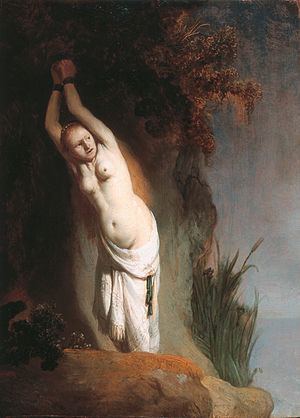Year c. 1630 Created 1631 Genre History painting | Media Oil paint Periods Baroque, Dutch Golden Age | |
 | ||
Dimensions 34 cm × 24.5 cm (13 in × 9.6 in) Similar Rembrandt artwork, Baroque artwork, Oil paintings | ||
Andromeda Chained to the Rocks (1630) is a 34 x 25 oil on panel painting by the Dutch Golden Age painter Rembrandt. It is now in the Mauritshuis, The Hague, Netherlands. Andromeda represents Rembrandt's first full length mythological female nude history painting and is taken from a story in Ovid's Metamorphoses.
Contents
Mythology
In Metamorphoses, Andromeda (mythology) is the daughter of an Ethiopian king and queen, Cepheus and Cassiopeia. Cassiopeia was very boastful about her beauty, and asserted that she was more beautiful than Juno, the queen of the gods and the Nereids. Insulted by Cassiopeia's assertions, Neptune sent a sea monster to the Ethiopian coast. Neptune then could only be appeased upon the sacrifice of Andromeda, the kings beautiful virgin daughter, to the sea monster. Andromeda was chained naked to rocks by the coast, awaiting the sea monster. Perseus, passing by, had noticed the beautiful girl and made a deal with her parents that he would save her, should he be allowed to have her hand in marriage. The king as queen agree and andromeda was spared.
Damsel in Distress
This painting depicts a classic example of the damsel in distress. In this theme a beautiful young woman is placed in a perilous situation, usually involving a monster or being trapped in captivity. The damsel can then only be rescued by a hero, whom of which she usually ends up marrying. In this painting, Andromeda has a distressed look on her face as she is completely shackled and unable to move. Although Perseus does not make an appearance in this painting, in similar works we can see Perseus being portrayed in a heroic and graceful light, shown through the use of warm colors and heroic poses.
Depiction of Beauty
Many artists such as Titian have depicted this story by showing Andromeda, her rescuer Perseus, and the sea monster all in the same composition. Her beauty as described in her source material can be seen in some of these other works, along with Perseus' role as her rescuer. In this work, Rembrandt shies away from classical conventions by showing her not as a glamorous beauty but as a frightened naturalistic looking girl. No other figure is included, but her alarmed look out of the picture space to the right creates narrative tension. The painting is an example of Rembrandt's rejection of idealized beauty. Since he did not believe true beauty existed naturally, he painted women as he saw them; naturally imperfect and flawed.
Rembrandt's subsequent nude mythological paintings from this period Diana Bathing and Danaë show his evolving portrayal of the nude.
